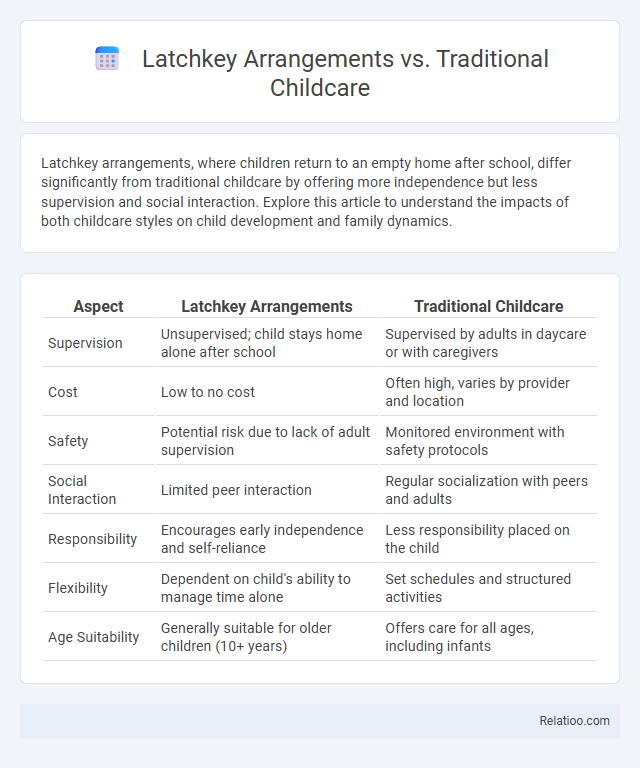Latchkey arrangements, where children return to an empty home after school, differ significantly from traditional childcare by offering more independence but less supervision and social interaction. Explore this article to understand the impacts of both childcare styles on child development and family dynamics.
Table of Comparison
| Aspect | Latchkey Arrangements | Traditional Childcare |
|---|---|---|
| Supervision | Unsupervised; child stays home alone after school | Supervised by adults in daycare or with caregivers |
| Cost | Low to no cost | Often high, varies by provider and location |
| Safety | Potential risk due to lack of adult supervision | Monitored environment with safety protocols |
| Social Interaction | Limited peer interaction | Regular socialization with peers and adults |
| Responsibility | Encourages early independence and self-reliance | Less responsibility placed on the child |
| Flexibility | Dependent on child's ability to manage time alone | Set schedules and structured activities |
| Age Suitability | Generally suitable for older children (10+ years) | Offers care for all ages, including infants |
Introduction to Latchkey Arrangements and Traditional Childcare
Latchkey arrangements involve children caring for themselves at home without adult supervision, typically after school hours, promoting independence but requiring clear safety measures. Traditional childcare offers structured environments with professional caregivers providing educational activities and social interaction, ensuring constant supervision and developmental support. Your choice between these options depends on factors like safety, social needs, and family schedules.
Defining Latchkey Arrangements: Key Features
Latchkey arrangements refer to childcare situations where children take care of themselves at home for a period of time after school without adult supervision, often due to parents' work schedules. Key features include children having access to a house key, responsibility for their own safety and routine, and the absence of formal caregiving or structured activities. This contrasts with traditional childcare, which typically involves supervised, organized settings such as daycare centers or after-school programs.
What Constitutes Traditional Childcare?
Traditional childcare encompasses supervised environments such as daycare centers, preschools, and licensed home-based care, offering structured activities and professional caregivers. It emphasizes consistent adult supervision, safety protocols, educational development, and social interaction tailored to children's age groups. Unlike latchkey arrangements where children care for themselves after school hours, traditional childcare provides continuous oversight and developmental support throughout the day.
Comparing Supervision: Independence vs. Structured Care
Latchkey arrangements provide children with greater independence and self-supervision, allowing them to develop self-reliance but may lack immediate adult oversight in emergencies. Traditional childcare offers structured supervision with trained caregivers ensuring safety, guided activities, and social interaction, fostering a secure environment. Latchkey situations emphasize autonomy but can pose risks due to limited adult presence, contrasting with the consistent, structured care of traditional childcare settings.
Social and Emotional Impact on Children
Latchkey arrangements, where children are left unsupervised after school, can lead to feelings of loneliness and anxiety, negatively impacting emotional development compared to traditional childcare settings that provide structured social interaction and support. Traditional childcare offers consistent adult supervision and peer engagement, fostering social skills and emotional resilience that latchkey situations often lack. Your choice between these options directly influences your child's ability to develop secure attachments and positive social behaviors.
Cost Considerations: Affordable Options and Hidden Expenses
Latchkey arrangements typically offer lower upfront costs compared to traditional childcare, making them a more affordable option for many families seeking independence for school-age children. Traditional childcare, while more expensive due to structured supervision and educational programs, may include hidden expenses such as registration fees, meals, and transportation costs. Families should carefully evaluate both options for hidden costs, including potential increased expenses in latchkey arrangements like emergency care or after-hours support.
Flexibility and Scheduling in Childcare Choices
Latchkey arrangements provide significant flexibility by allowing children to manage their own time after school without fixed supervision, contrasting with traditional childcare that follows strict schedules and structured activities. Your choice between latchkey and traditional options depends on how much control you want over your child's after-school routine and the balance between independence and oversight. Flexibility in scheduling with latchkey can benefit families with unpredictable work hours, while traditional childcare offers consistent timing for better routine and social engagement.
Safety Concerns and Risk Management
Latchkey arrangements often raise safety concerns due to the lack of immediate adult supervision, increasing risks of accidents or emergencies going unnoticed. Traditional childcare provides structured environments with trained caregivers, significantly reducing safety risks through constant monitoring and established protocols. Your choice should weigh the balance between flexibility and ensuring comprehensive risk management to protect your child's well-being effectively.
Effect on Child Development and Academic Performance
Latchkey arrangements often result in less supervision, potentially leading to increased behavioral problems and lower academic performance compared to traditional childcare settings with structured activities and adult guidance. Traditional childcare promotes social skills, emotional regulation, and cognitive development through interaction with peers and trained caregivers, positively influencing your child's academic success and overall development. In contrast, purely latchkey situations may increase risks of loneliness and reduced academic motivation, underscoring the importance of combining supervision with enriching experiences for optimal child development.
How to Choose the Best Option for Your Family
Choosing the best childcare option depends on your family's schedule, budget, and your child's needs, with latchkey arrangements offering independence for older children while traditional childcare provides structured supervision and socialization. Evaluate factors such as safety, convenience, and the child's maturity level when deciding between self-care at home under latchkey supervision or enrolling in traditional childcare programs with trained caregivers. Prioritizing open communication, clear guidelines, and regular check-ins ensures the chosen solution supports both your child's well-being and your family's lifestyle.

Infographic: Latchkey Arrangements vs Traditional Childcare
 relatioo.com
relatioo.com